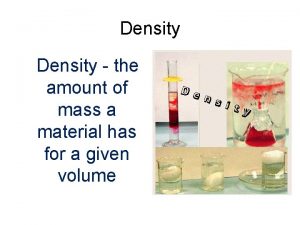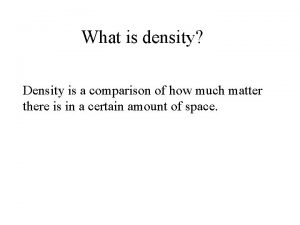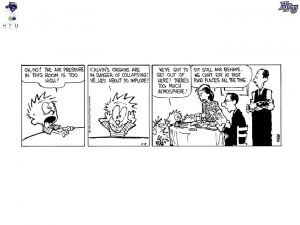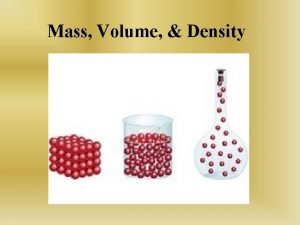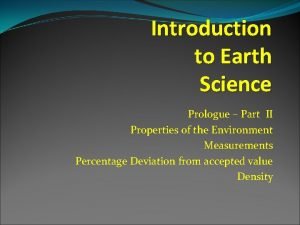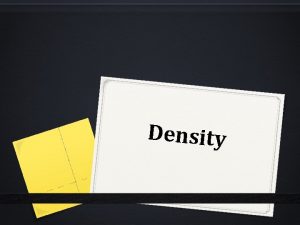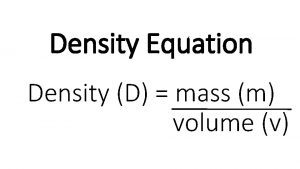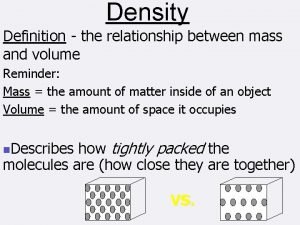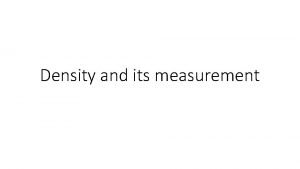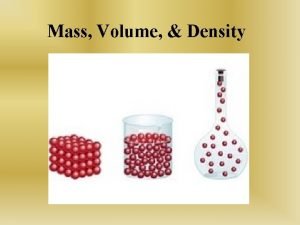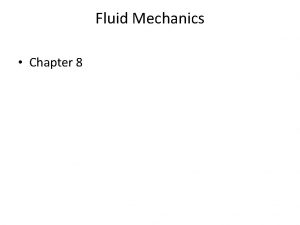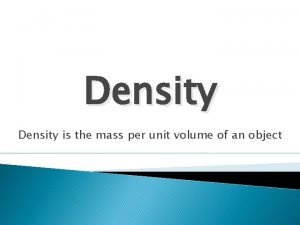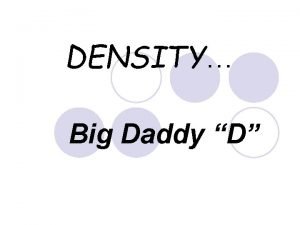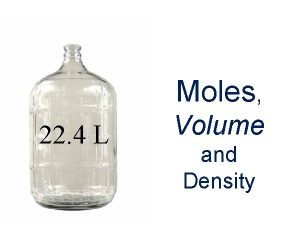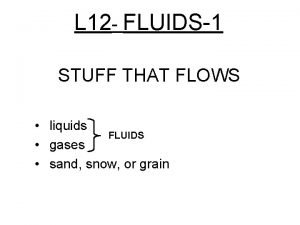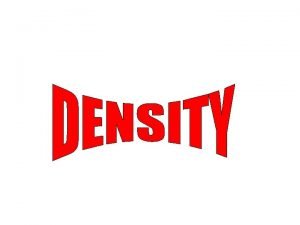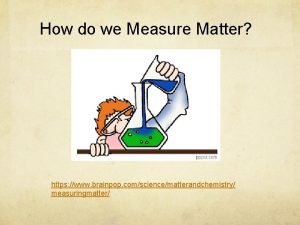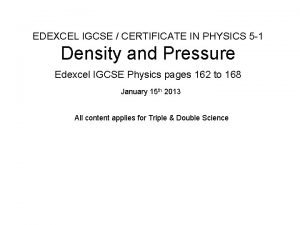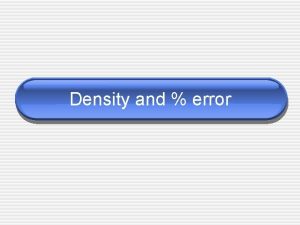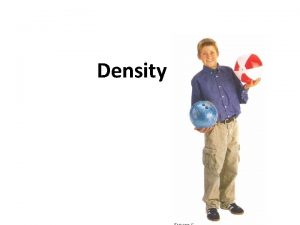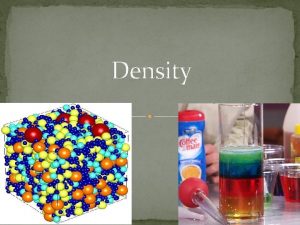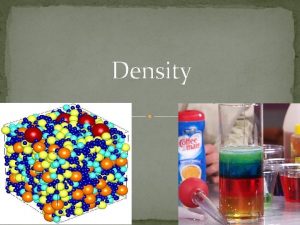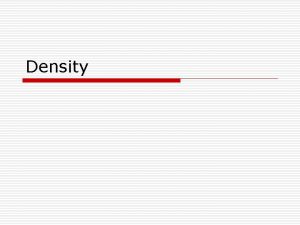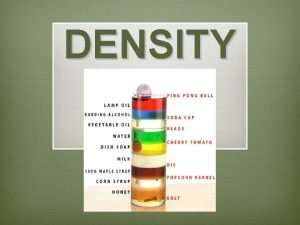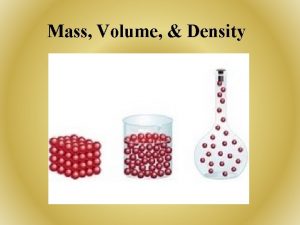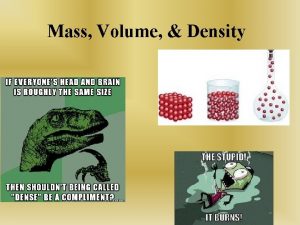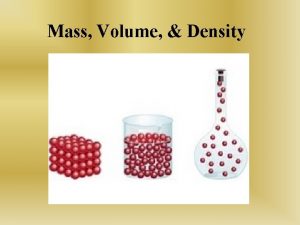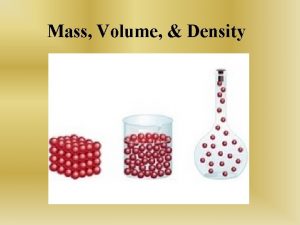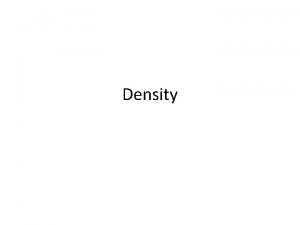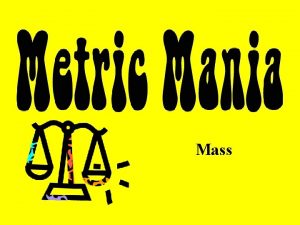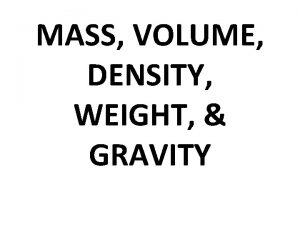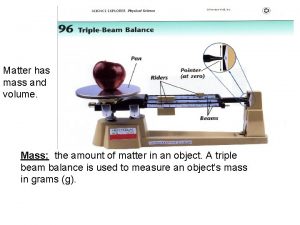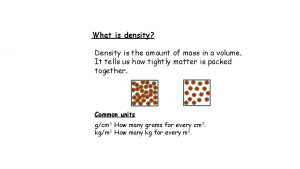Density the amount of mass a material has




































- Slides: 36

Density - the amount of mass a material has for a given volume

We can calculate density using the formula: Density= Mass/Volume or D = m/v . A concrete cube will weigh more than a cube of air the same size because it is denser

Song on density formula http: //www. youtube. com/watch? v=Vf. M DC 4 gu. XZg

Density is measured in: • • g/cm 3 kg/m 3 g/m. L kg/L

If each ball has the same mass, which box would weigh more? Why? • The box that has more balls has more mass per unit of volume. This property of matter is called density. The density of a material helps to distinguish it from other materials. Since mass is usually expressed in grams and volume in cubic centimeters, density is expressed in grams/cubic centimeter.

• Copper atoms are smaller than aluminum atoms. • More copper atoms can fit in the cube. • Copper atoms are also heavier than aluminum atoms. • The combination of more and heavier atoms makes copper more dense than aluminum. Lab: What is Density? http: //www. middleschoolchemistry. com/multimedia/chapter 3/lesson 1

Arrangement of Atoms More dense Less dense More mass (matter) in a given volume Less mass (matter) in a given volume

Mass of Individual Atoms Affects Density • Some individual atoms or molecules have a greater mass than other atoms or molecules which can cause a substance to be more dense


Density of water = 1 g/cm 3 or 1 g/m. L

Formula: Problem: Show Work: Answer: 2. The density of water is 1 g/cm 3. Will the ice cube sink or float in water?

Ice is less dense than water


Seven Layer Density Column Material. Density in g/cm 3 or g/m. L Rubbing Alcohol. 79 g/cm 3 Lamp Oil. 80 g/cm 3 Baby Oil. 83 g/cm 3 Vegetable Oil. 92 g/cm 3 Ice. Cube. 92 g/cm 3 Water 1. 00 g/cm 3 Milk 1. 03 g/cm 3 Dawn Dish Soap 1. 06 g/cm 3 Light Corn Syrup 1. 33 g/cm 3 Maple Syrup 1. 37 g/cm 3 Honey 1. 42 g/cm 3

How does temperature effect density?

DMV Triangle m is the top of the mountain

Warm Up 1. A block of aluminum occupies a volume of 15. 0 m. L and weighs 40. 5 g. What is its density? 2. Mercury metal is poured into a graduated cylinder that holds exactly 22. 5 m. L. The mercury used to fill the cylinder weighs 306 g. Calculate the density of the mercury. Use this format for both problems: Formula: Problem: Show Work: Density =

Warm Up 1. A rectangular solid of unknown density is 5 meters long, 2 meters high and 4 meters wide. The mass of this solid is 300 grams. What is its density? Formula: Problem: Show Work: Volume = Density =

Warm Up 1. The density of lead is 11 g/m. L. What would the volume of a 200. 0 g sample of this metal be? Formula: Problem: Show Work: Density =

Volume Challenge #1 R. Bryant 2008 WSMS – Based on “Science Starters” by T. Trimpe at http: //sciencespot. net

Determine the volume of this cube. m 5. 7 cm c 5. 7 cm

The answer is … Volume = length x width x height l = 5. 7 cm w = 5. 7 cm h = 5. 7 cm V = 5. 7 cm x 5. 7 cm V = 185. 19 cm 3

Density #1 R. Bryant 2008 WSMS – Based on “Science Starters” by T. Trimpe at http: //sciencespot. net

Find the density of the box below. Mass 456 g 12. 5 cm 5. 6 cm

The solution … Volume = length x width x height V = 12. 5 cm x 5. 6 cm V = 392 cm 3 M = 456 g Density = Mass ÷ Volume D = 456 g ÷ 392 cm 3 D = 1. 16 g/cm 3 **The box would sink!

Density #2 R. Bryant 2008 WSMS – Based on “Science Starters” by T. Trimpe at http: //sciencespot. net

Find the density of the box below. Mass 386 g 23. 5 cm 7. 8 cm 6. 4 cm

The solution … Volume = length x width x height V = 23. 5 cm x 7. 8 cm x 6. 4 cm V = 1173. 12 cm 3 M = 386 g Density = Mass ÷ Volume D = 386 g ÷ 1173. 12 cm 3 D = 0. 33 g/cm 3 **The box would float!

Density #3 R. Bryant 2008 WSMS – Based on “Science Starters” by T. Trimpe at http: //sciencespot. net

Find the density of the object below. An object was dropped into a graduated cylinder that contained 20 m. L. Determine the volume of that object. The object was The mass placed on a triple beam balance. Image from http: //ritter. tea. state. tx. us/ Image from http: //genchem. rutgers. edu/bal 3 b 2. html

The solution … Volume = Volume of water & object – volume of water Volume = 43 m. L – 20 m. L V = 23 m. L M = 373. 3 g Density = Mass ÷ Volume D = 373. 3 g ÷ 23 m. L D = 16. 23 g/m. L

Density #4 R. Bryant 2008 WSMS – Based on “Science Starters” by T. Trimpe at http: //sciencespot. net

Find the density of the object below. The object was placed on a triple beam balance. 20 0 An object was dropped into a graduated cylinder that contained 40 m. L. Determine the volume of that object. 5. 4 Image from http: //www. edinformatics. com/math_science/mass. htm

The solution … Volume = Volume of water & object – volume of water V = 65 m. L – 40 m. L V = 25 m. L M = 25. 4 g Density = Mass ÷ Volume D = 25. 4 g ÷ 25 m. L D = 1. 01 g/m. L ** The object will sink!

• Eureka video on volume and density: • http: //www. youtube. com/watch? v=GMNp. P g. LT 8 Fk

• Eureka Video on volume and density http: //www. youtube. com/watch? v=GMNp. Pg LT 8 Fk • Eureka Video on density and buoyancy • Dr Carlson on density (displacement) • http: //www. youtube. com/watch? v=14 nah. P _FVn. M
 Dmv triangle
Dmv triangle Density of golden syrup g/cm3
Density of golden syrup g/cm3 Specific gr
Specific gr Planar density of bcc 111
Planar density of bcc 111 Physiological density
Physiological density Linear density of fcc 110
Linear density of fcc 110 Nda full dac
Nda full dac What does arithmetic density tell us
What does arithmetic density tell us Quantity has magnitude only
Quantity has magnitude only Common material densities
Common material densities Density
Density Dmv triangle
Dmv triangle Mass density volume questions
Mass density volume questions How to find volume density and mass
How to find volume density and mass Mass equals density times volume
Mass equals density times volume Density triangle
Density triangle Mass and volume to density
Mass and volume to density Which has a greater mass?
Which has a greater mass? Definition of mass volume and density
Definition of mass volume and density Density mass and volume triangle
Density mass and volume triangle Brain pop density
Brain pop density Mass and volume to density
Mass and volume to density Is oil more dense than water
Is oil more dense than water Mass density in fluid mechanics
Mass density in fluid mechanics Mass per unit volume
Mass per unit volume Big daddy definition
Big daddy definition Mass density unit
Mass density unit Moles and density
Moles and density Mass density unit
Mass density unit Density triangle units
Density triangle units V=density/mass
V=density/mass Density mass and volume
Density mass and volume Density measures an object's brainpop
Density measures an object's brainpop Igcse density questions
Igcse density questions Engineering drawing symbols and meanings
Engineering drawing symbols and meanings Rsq in standard costing
Rsq in standard costing Non material culture
Non material culture
